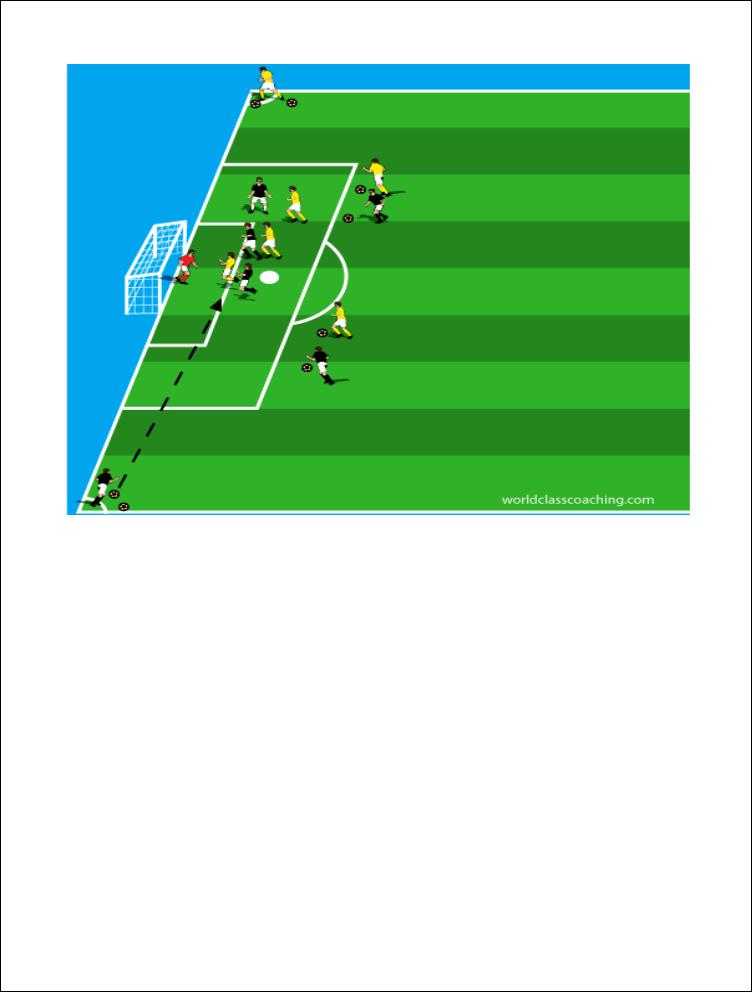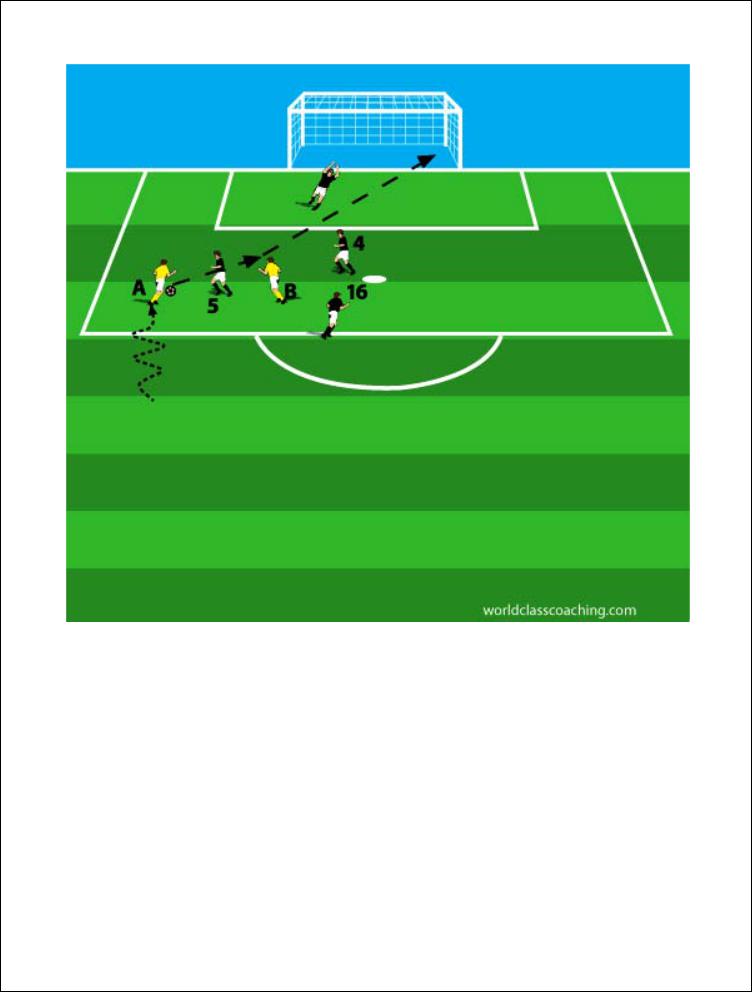
FCBarcelona
.pdf
5 vs. 3 to goal ½ field This practice continues expanding the finishing group and adds a functional element, allowing the attacking midfielders to work with the front line players. Organize the attackers as two attacking midfielders (one starts with the ball) and three forwards. The defenders play a flat three. If the defenders win possession, the ball is dead and play restarts with the midfielders. The attackers must work to overlap one of the attacking midfielders before shooting at the goal. This environment is a useful setting for either letting the players figure out how to create the overlap for the midfielders or for testing the patterns outlined below.
3 teams to goal inside the area Because Barcelona are built to avoid playing in the air in the box, many of their goals result from quick, thoughtful play in possession inside the area. Create 3 equal teams. Two teams play to goal (against the goalkeeper) inside the 18-yard box, while the third team serves restarts (from the edge of the area and the ‘D’) and also plays first time any ball popping out of the box. The resting team earns points for goals scored off of serves. The other two teams earn points for goals. The goalkeeper earns a point for every difficult save. Play three five minute games (each team plays twice).
©WORLD CLASS COACHING |
Page | 110 |
FC Barcelona – Style and Domination |

Team trains ‘keeper goal box area Similar to the exercise above but with two teams and the added element of finishing crosses. Create two equal teams. Each team places three players in the goal box area and one crosser in one of the corner areas. The remaining players get a ball supply and spread out across the top the 18-yard box. The goalkeeper calls out names of servers (players on the top of the 18 can shoot or pass and players at the corners serve crosses) for each restart. When a player at the top of the 18-yard box opts to shoot, the players inside the box must clear the area of the 6 yard box for the goalkeeper. The ball is live as long as it remains inside the 18-yard box. Play for five minutes and then rotate servers and active players.
Variation:
•Add a Barcelona-inspired short corner (one player checks to the server) to the restart possibilities.
©WORLD CLASS COACHING |
Page | 111 |
FC Barcelona – Style and Domination |

Beating Barcelona
Given the team’s impressive run since 2008, debate rages as what sort of team and tactics will be required to defeat Barcelona. This is an especially interesting debate given that Guardiola and his team are so adamant that playing ‘their football’ is as important to them as their results. Thus, in scheming against Barcelona, it’s not just a team that one confronts, but a stubborn tactical belief and one that has, to this point, proven remarkably successful.
Tactically, there are some precepts that would suit a team well in trying to defeat Barcelona.
Counter Attack
Because Barcelona are so intent on possessing the ball and because they spread people (particularly their back line) all over the field, they are definitively vulnerable to quick, intelligent counter-attacks. It’s clear that many Barcelona opponents think in these terms and it’s also evident Barcelona are aware of the danger, as they put such a premium on smothering the ball immediately after it’s lost. The successful counterattack moves the ball quickly and over distance after the ball is won, thus defeating Barcelona’s attempts to run as many players as possible at the ball after a turnover.
It would seem that the best place to build counter-attacks against a typical Barcelona lineup would be on the flanks and deep. Alves, who played so many games as a right back, is there in tactical description only for the most part and Abidal, who is typically the left back, is less venturesome overall, but still pushes forward and leaves an interior seam that can be exploited (as Madrid did in the third edition of the Classico in January, 2012, when Christiano Ronaldo snuck inside and scored). Probing in the middle of the field usually draws holding midfielder Busquets’ attention and counters here are tough to establish or sustain in momentum because Piquet and Puyol are very good at closing space together.
©WORLD CLASS COACHING |
Page | 112 |
FC Barcelona – Style and Domination |

Ibrahimovic from Seedorf vs. Barcelona (3-2) (Champions League 2011)
In an instructive example of how and where to counterattack Barcelona, AC Milan’s Clarence Seedorf dribbles at speed into space, isolating himself vs. Puyol (5). Former Barcelona star Zlatan Ibrahimovic (B) makes a late run inside of Puyol and Seedorf makes a nice touch pass into space for Ibrahimovic to run onto and finish. Barcelona were caught way out of defensive balance in this situation and Puyol (slow to pressure and completely ignorant of Ibrahimovic’s run), Busquets (16) (slow to recover and failed to track Ibrahimovic’s late run) and Javier Mascherano (4) (failed to fill in behind Puyol or pick up Ibrahimovic’s run), who was playing as a center back on this day, were equally culpable for the breakdown.
©WORLD CLASS COACHING |
Page | 113 |
FC Barcelona – Style and Domination |

Santos vs. Barcelona (4-0)( FIFA Club World Cup 2011)
The above slide shows another danger inherent in Barcelona’s ball-chasing defensive mentality. Although Barcelona’s dismantling of South American Champion Santos was comprehensive, there were several moments, particularly in the first half, when the European champions looked vulnerable. Santos player A, above, has gotten into space on the dribble on the edge of Barcelona’s back line. Puyol (5) steps to the ball. Pique (3), the center back, slides in to support and Abidal (22), the left back, also pulls across the formation to keep tight with Pique. Busquets (16) tracks back ball-side in support. The area at the back side of the defense, where player B is running, is extremely vulnerable at this moment. Santos seemed to understand this opportunity, and they did earn a couple shots from that area by attacking to their left and then quickly switching the ball. Indeed, it’s not immediately evident in the Barcelona system who would be responsible for this space if Abidal either overplays the danger to his right or if he is compelled to tighten up on Pique by another runner. Busquets could be called into this space, but he tends to recover ball side and threaten support areas for the opponent in possession. The next best option here would be one of the attacking midfielders, and both Xavi and Iniesta make important
©WORLD CLASS COACHING |
Page | 114 |
FC Barcelona – Style and Domination |

defensive runs in every game, but often both are pushed up very high and this back-side space is thus an area of weakness for Barcelona in defensive transition.
Earn Set Pieces
The Barcelona approach to attacking corners, which is to play short most of the time, is an indication (because of their relative lack of size) of their feeling that they will not likely win many balls in a crowded goal area. Thus, it would behoove teams to run the ball to the endline (i.e. in counter-attacking situations, where it’s easiest to find flank space and work deep into Barcelona’s back third) and try to force crosses and corners. After Puyol, Pique and Busquets, Barcelona’s typical starting lineup lacks height and is not as comfortable playing in the air. Similarly, goalkeeper Valdes, while an accomplished shot-stopper and very good in possession, appears to be prone to the occasional gaffe (and less than dominant physically) when compelled to handle service in the air under pressure. The same considerations would apply, naturally, regarding free kicks into the area, though Barcelona are more disciplined than most regarding avoiding fouls and particularly in their back third.
Batter Them at Every Opportunity
Though a very cynical approach, this appears to be Jose Mourinho and Real Madrid’s approach to playing Barcelona in 2011-2012. In the second and especially the third version of the Classico, games played as part of the Copa Del Rey competition (which Barcelona won on aggregate 4-3 after a 2-1 win at the Bernebeu and a 2-2 draw at Camp Nou), Real committed numerous blatant fouls all over the field and seemed intent on intimidating and even hurting Barcelona stars Messi, Xavi and Iniesta, among others. The approach appeared to finally pay dividends in the final twenty-two minutes of the latter match, when both Cristiano Ronaldo and Kareem Benzema netted goals off of Barcelona mistakes in their back third and Barcelona’s ability to control the middle of the field waned under the strain.
Do not Play from Behind
Given the possession-obsessed approach that Barcelona bring, it is critical that opponents not fall behind, as then their ability to drain minutes from the game, as well as the energy of opponents who are obliged to press them, comes into play. This concern was very evident in 2011-2012’s first edition of the Classico, when Barcelona earned a 3-1 lead mid-way through the second half. Real Madrid looked tired and dispirited and basically chased the game all of the way up until the final whistle.
Play with a Lead
Contrarily, staking one’s team to a lead can be very advantageous against Barcelona. Although they typically and stubbornly cling to knocking the ball around regardless of the score, the weight of expectation does sometimes wear on Barcelona. A prime example was the shocking 0- 1 loss to Getafe in the first round of the 2011-2012 season. Barcelona blew a number of early opportunities and once they fell behind, looked out of sorts both in their possession and also in their recognition of the need to force an equalizer. Certainly any team able to earn and hold a
©WORLD CLASS COACHING |
Page | 115 |
FC Barcelona – Style and Domination |

lead against Barcelona would enjoy the evolution of a tactical dilemma for the Catalans as they try to be patient and also watch the time slip away.
Low Pressure in the Front Third and Hold a High Line
Real Madrid and others have tried this approach and it makes sense. By conceding their back third to Barcelona and holding a high line, opponents compress the game and give themselves a better chance of disrupting Barcelona’s possession. Lending further weight to this proposition is the fact that Barcelona seem to see this as a bit of a challenge and don’t generally just play in behind to stretch and wear the opposing defense (a little surprising given that the team sometimes field front lines featuring Messi, Villa and Pedro). It appears, given Guardiola’s comments on the subject, that Barcelona are determined to play their way, and if the opponents want to compress and flood midfield space, Barcelona will demonstrate that it won’t matter. To be fair, there are instances where such tactics actually play into the hands of Barcelona, as a high tight team is often very vulnerable to the angled, high passes to the backside space (i.e. for an overlapping Alves) outlined earlier, and Barcelona do occasionally punch the ball through centrally and let Messi or Fabregas run, which is a frightening prospect for the opposing coach in planning.
©WORLD CLASS COACHING |
Page | 116 |
FC Barcelona – Style and Domination |

Conclusion
Barcelona under Pep Guardiola brought about a tactical revolution wherein the ‘team’ concept of football was raised to a new and very appealing level. Through superior technical, tactical and physical speed, a selfless philosophy and superior management, a fluid possession-obsessed team ran off a series of impressive domestic and international results that continues through the completion of this book. Though FC Barcelona have until recently relished the role of upstart in Spain and Europe, they will likely be the gold standard for the game for years to come.
Best wishes in your coaching.
©WORLD CLASS COACHING |
Page | 117 |
FC Barcelona – Style and Domination |

Sources www.espn.go.net www.fcbarcelona.com
http://www.spain-football.org/josep-guardiola.html www.uefa.com
www.goal.com www.footballmundial.co.uk www.zonalmarking.net www.laligablog.net www.arsenalcolumn.wordpress.com
Burns, Jimmy. Barca: A People’s Passion. London: Bloomsbury Publishing, 2009.
Simon Kuper. Soccer Men: Profiles of the Rogues, Geniuses and Neurotics Who Dominate the World’s Most Popular Sport. New York: Nation Books, 2011.
Longman, Jere. The Catalan Way to Grow Players on Home Soil. www.nytimes.com 5/26, 2011.
Tom Williams. ‘Tactics: How Barcelona have changed football.’ www.tomwfootball.com
Jonathan Wilson. ‘Why are teams so tentative about false nines?’ The Guardian, 10/27/2009.
_____________ Inverting the Pyramid: A History of Football Tactics. London: Orion Books, 2008.
Also by Tony Englund and World Class Coaching
Goalie Wars: ‘Keeper Training in a Competitive Environment (2009)
Players’ Roles and Responsibilities in the 4-3-3: Attacking (2010)
Players’ Roles and Responsibilities in the 4-3-3: Defending (2010)
©WORLD CLASS COACHING |
Page | 118 |
FC Barcelona – Style and Domination |
